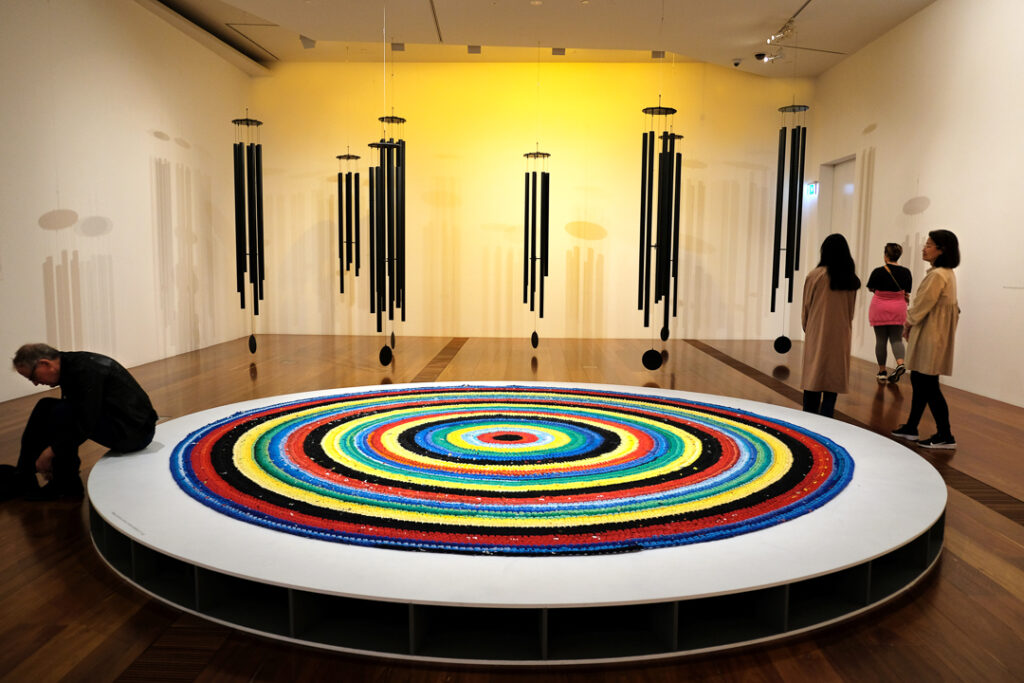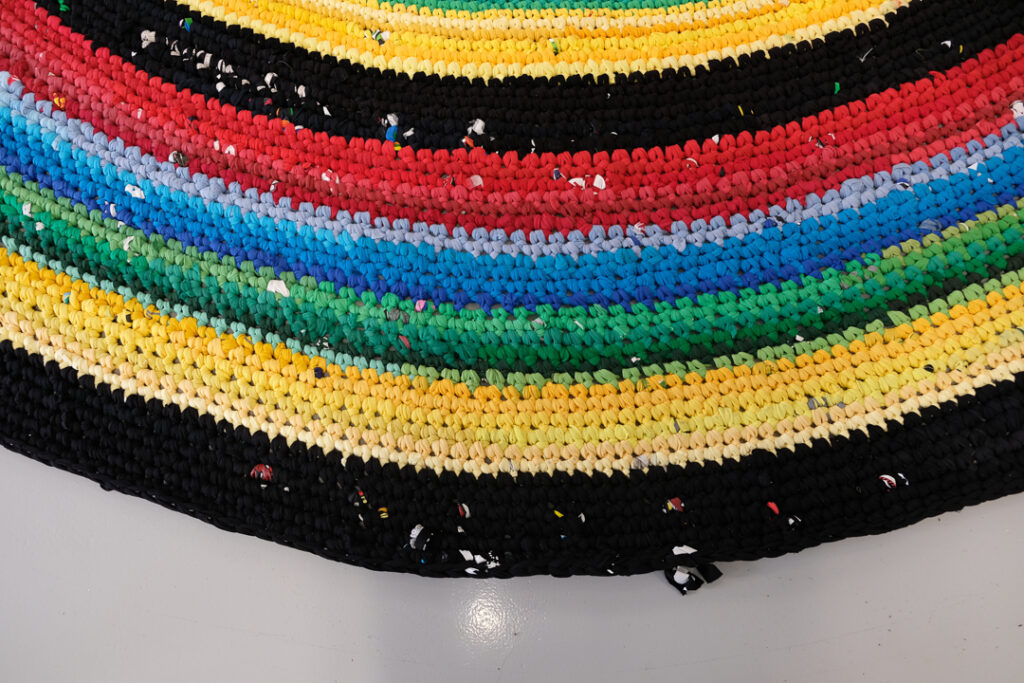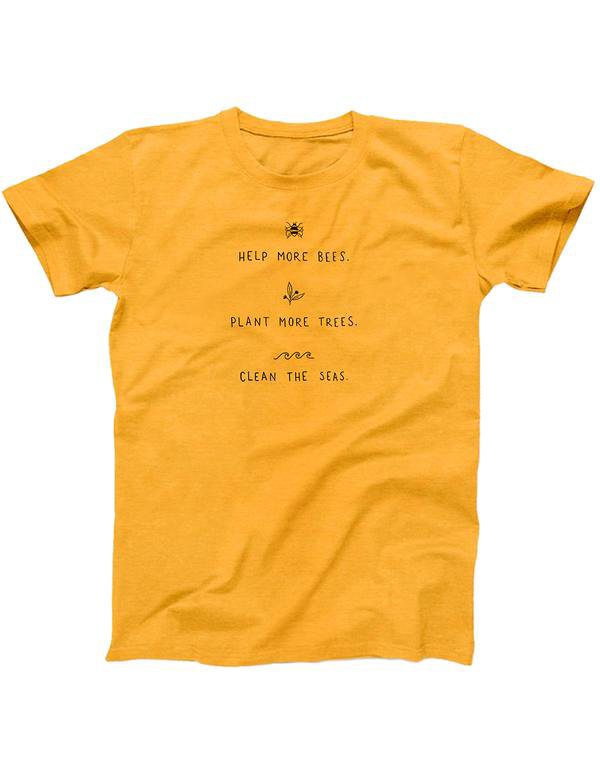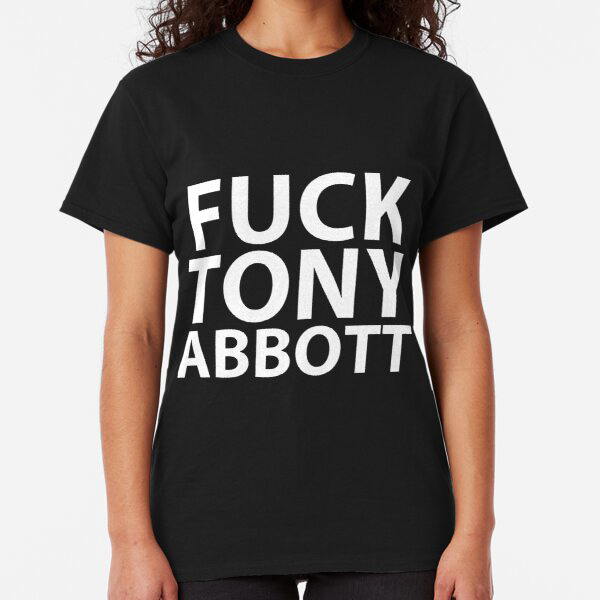
Jan Nelson, Black River Running #13: 32kgs, 2017-2022, Crocheted round rug made from secondhand protest tee shirts, Size: diameter 4 metres; Black River Running #14: 33.54 minutes, 2020 – 2022, 8 x Windchimes: Black aluminium tubes, timber, metal, foam and wire components, size: variable.
Jan Nelson speaks about the making of sound and woven works that reflect the fraught history of protest.
Melbourne Now 2023 at the National Gallery of Victoria featured two major works by Jan Nelson. Laying horizontally on a large circle on the floor was a rug made from old protest t-shirts. Next to this, hanging vertically, were sets of chimes that contained notes from protest songs of the past.
It is easy to succumb to nostalgia when evoking the collective solidarity of past protests. Jan Nelson’s work allows the gallery visitor to experience this time in a way that retains the sense of fragmentation. These glimmers of the past acknowledge its disappearance.
We ask Jan Nelson about the origins and making of these works.
✿ Can you say how the rug came about?
I have been working on this piece for years as it has required collecting hundreds of tee shirts promoting different activist and protest groups. I achieved this by trawling op shops and internet sites. I then categorized the tee shirts into their various colour codes. For example, the green tee-shirts relate to the Green movement, yellow to Save the Bees, blue to the ocean or Save the Whales and black to such movements as Black Lives Matter, the Occupy movement, Sea Shepherd or The Fuck Tony Abbott campaign. These were then cut into strips and crocheted together to a 4-metre round rug, the content revealing itself only by the occasional glimpse of printed material. The idea being that to authenticate the content, you must destroy the rug and its physical meaning.
✿ Did you use any new t-shirts?
No, I felt it was wrong to buy new t-shirts. The whole idea for me was it was an embodiment: you could still smell the perfumes, the deodorants, and the body odour of the previous owner. The rug only gives a glimpse of the message. It’s hidden because it is woven into the collective body of the rug. Conceptually the work charts our contemporary political and social problems; it symbolizes the weight of the world’s never-ending conveyer belt of concerns. It speaks to the vulnerable body, as in the pre-worn tee shirts identifying with ideas of change and to the force of the defiant collective. It also speaks to ideas of endurance and duration.
✿ How did the idea of the chimes come about?
I’d been to several protests in the city and was very aware of standing there as an individual, but I was also really taken with how one voice becomes a collective cacophony of noise.
And so I began thinking about how particular songs or note structures have represented protests over the decades. I started with the 1930s and Billie Holiday’s Strange Fruit and then worked through the decades until I got to Paul Kelly’s Sleep Australia Sleep in 2020. Instead of taking the whole song, I took a riff out of the melody, and maybe five, six, seven notes, that represented the song.
Conceptually the windchimes are a collective made up of individual voices, all sounding out to create a note here and there, a chorus or a cacophony of noise, much like what happens at a protest. This piece reflects the cultural drift from the past to the present. The piece is based on the homely wind chime, although my version is quite different. It takes the form, but I have deliberately skewed the concept from having an amateur vibe that embraces domesticity and alternative culture to having a much darker presence.
✿ How were they made?
To make the wind chimes I chose a melodic riff in each song, which equated to five or six or seven consecutive notes. Using a sound engineer’s calculator to obtain the individual note, I then married the length, diameter and thickness of the tube to a cut length and hang point. To get the exact note, you need to cut the tube within the millimetre, which was quite tricky and then, of course, I had to work out the components and method of production. I researched the piece during COVID as it gave me time to ponder on the complexity of the piece.
In the end, the most challenging part was not the cutting but working out how to get the central wire down inside the tube and to hang it securely so that the wire didn’t touch the sides.
✿ What connects these works together?
Formally, they’re both working on the round. There is the circular motion of the rug and the circular tubes making a circle hanging down.
What is essential for BRR#13 and 14 is that my audience feels the rug is something to lounge on and the windchimes are something they can interact with. This way, they can sound out their own lament in joining with the voices and bodies of others. I often feel like that about things. I think, how many years do we have to go through these issues, but we never seem to learn? We just repeat ourselves.
About Jan Nelson
Jan Nelson’s works exploit emotional, textural and chromatic intensity, oscillating between fear and power, complacency and dissent. Layered within the artist’s work is the personal experience of her own formative years during the social, political and cultural tumult of the 1970s. Nelson’s multi-disciplinary practice, which encompasses painting, sculpture, photography and installation, concentrates on the role of the visual in the construction and experience of the developing self. Both alluring and disquieting, her work’s dynamism stems from the artist’s preoccupation with states of change. The labour of the human hand, Nelson perceives as a performative act, exposing the gap between the constant striving towards perfection and the flawed reality of our idiosyncratic humanity. As Nelson states “as with all of my work, the meaning is contained within the process where the handmade meets acute industrial precision. Whether it is a hyper-real exact replica of a photograph or screen, an abstracted minimal rendering of stripes on a wall or the incessant manufacture of 3D objects, all are managed from a set of instructions, followed exactly to perform a kind of perfection, and more importantly, to give rise to problematising the very nature of representation. In acting out this exactness it is my aim to claim a type of witness to the anxiety and struggle of contemporary living”.
Jan Nelson has exhibited in numerous major local and international institutions, including the 2004 XXV Bienal de São Paulo, Brazil. She has received many scholarships, grants and awards, these include the John McCaughey Memorial Art Prize at the National Gallery of Victoria and the Arthur Guy Memorial Painting Prize, Bendigo Art Gallery. Her works are held in public collections throughout Australia and overseas. She is represented by the Anna Schwartz Gallery, Melbourne. Visit jan-nelson.com.




